
shape Things To come (2013)
The Lock-Up Culture Centre
Opening 530pm November 22
by Dr Jeffrey McGee
Senior Lecturer, Newcastle Law School
University of Newcastle
November 22 - December 8
90 Hunter St, Newcastle
Models of climate change trajectories show the shape of things to come for the biosphere and its inhabitants this century. Scientific organisations worldwide overwhelmingly maintain that the window to avoid runaway catastrophic climate change is closing fast: being one decade…at most. The Australian Climate Commission – decommissioned last month - have termed the decade 02010-02020 The Critical Decade, because climate trajectories within the window of now determine whether it is possibilie to limit global temperature increases to 2° above pre industrial levels, with 2° seen as the maximum increase possible without causing runaway climate change. The current global trajectory is to a 6° increase this century. In turn, highly reputed climate scientists - examples: here, here and here - and scientific organisations - examples: here, here and here - are now proposing radical ways to engineer the world’s climate through bioengineering and geoengineering.
shape Things To come explores this reversal of agency: from being shaped by things to come, to how humans may shape things to come through climate engineering interventions designed to separate existing lifeforms from 6 degrees of catastrophe. These proposed interventions are deliberate large-scale modifications of Earth’s climate system, rendering the planet as an artificially regulated entity. One of the more likely scenarios is injecting sulfur aerosols into the stratosphere, in mimicry of the effect volcano’s have in reducing temperatures. One of the side effects is that this intervention, which would be required without interruption into the future, would render the sky white.
Goodbye Blue Sky charts this trade off: between sea level rise versus the ‘blueness’ of the sky.
Take Money Run charts the analogy of the game humans are playing: of climate change as Russian roulette, where increasing temperatures are akin to exponentially more bullets loaded into the barrel of the gun we point at the life support systems that sustain life as we know it…
Stand Your Ground maps Take Money Run and Goodbye Blue Sky onto the nearby pump station at Newcastle Ocean Baths – where humans regulate the controlled environment of the Ocean Baths against the seemingly uncontrollable environment of the sea, by ceaselessly pumping water back out of the baths and into the ocean. The Ocean Baths sit at the shoreline: 700 metres east of gallery, about 130cm lower than the floor of the gallery, which is the physical height of the metal pump station door in Stand Your Ground. Sea level increases for each trajectory of 1, 2, 3, 4, 5 and 6 degree temperature increases are mapped onto the external environment of the metal pump station door, located precariously at the sea edge. These temperature and sea level increases are then mapped back onto the gallery environment through string running between the trajectories within Take Money Run and Goodbye Blue Sky. Doorways connect these global and local scale depictions of climate change via the string running past the gallery doors which maps the sea level rise trajectories onto these portals between domestic and exterior environments.
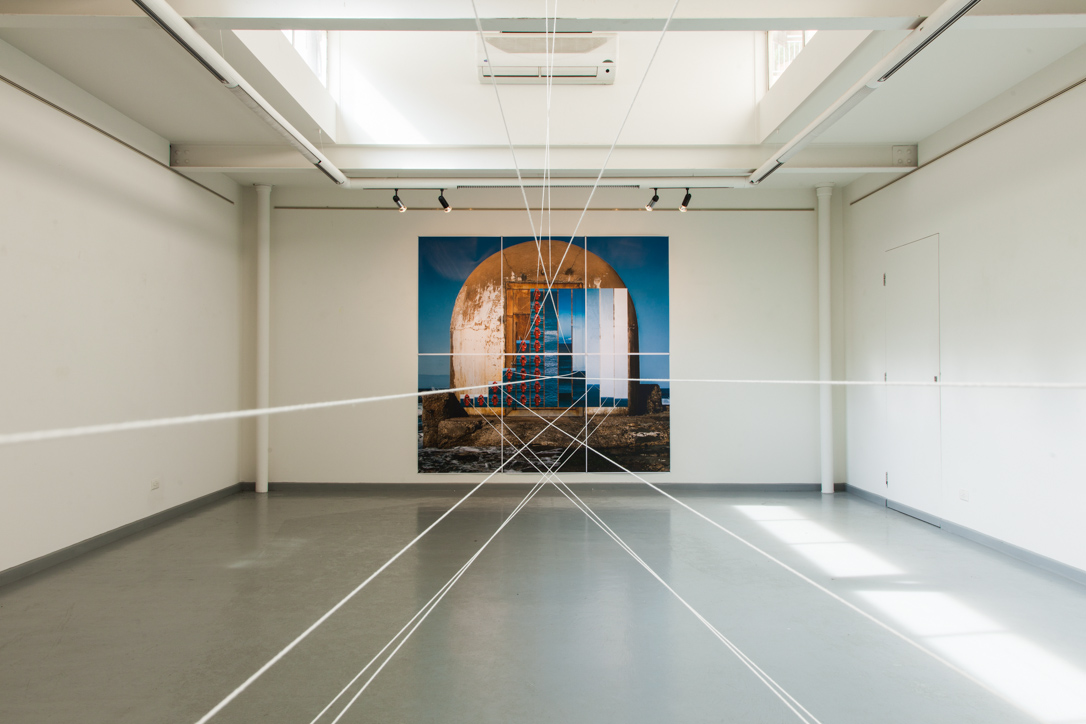
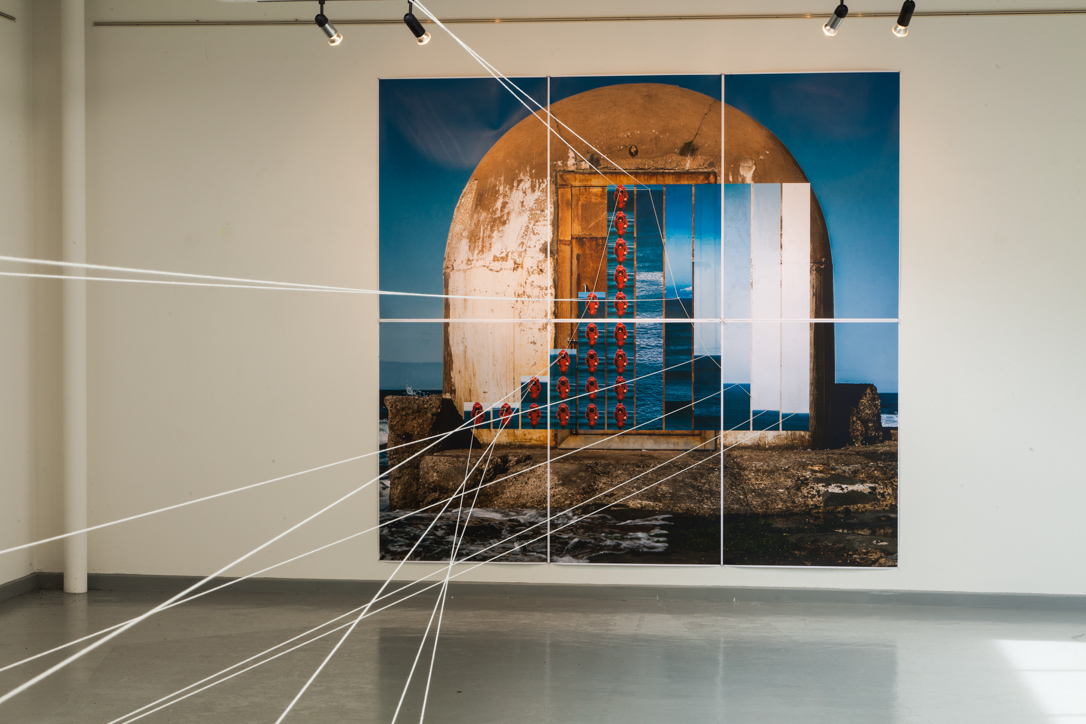
Stand Your Ground install views 1 and 2
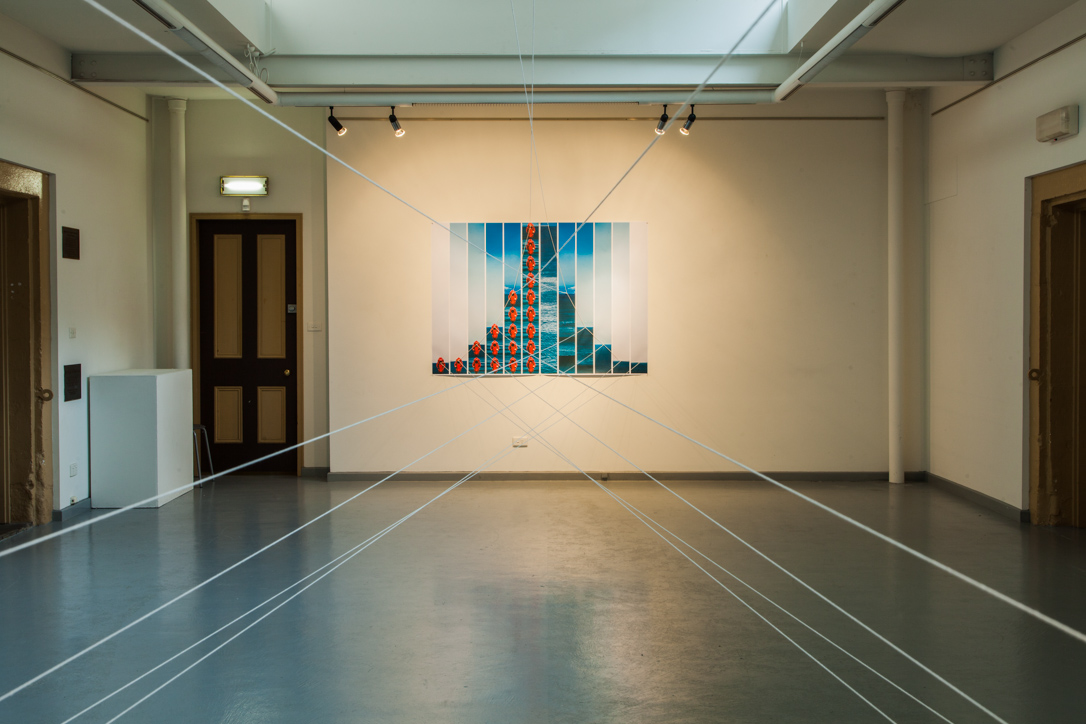

Take Money Run (left) and Goodbye Blue Sky (right) install views 1 and 2
The planetary scale climate change that is mapped onto the metal pump station door and gallery doors is mapped onto a similar sized object in the neighbouring room: the human body. The time lapse video portraits Jubilee Venn Diagrams? interfaces
the domains of climate (= global scale of eons, epochs and eras) and weather (the local, here and now)
by overlaying props (= the domain of climate)
on the human body (= the domain of weather).
where props = global average temperature (Red), sea level (Blue) and C02 (Green) levels
over time (= x-axis) and amount/level (= y-axis).
In these Vitruvian man variations:
right hand = The Past;
central axis = The Present
left hand = The Future.
As the props morph through the time lapse portraits they form scatter-plots threading together these past, present and future trajectories.





Six Degrees of Separation: Col from the series Jubilee Venn Diagrams? install views 1 - 5

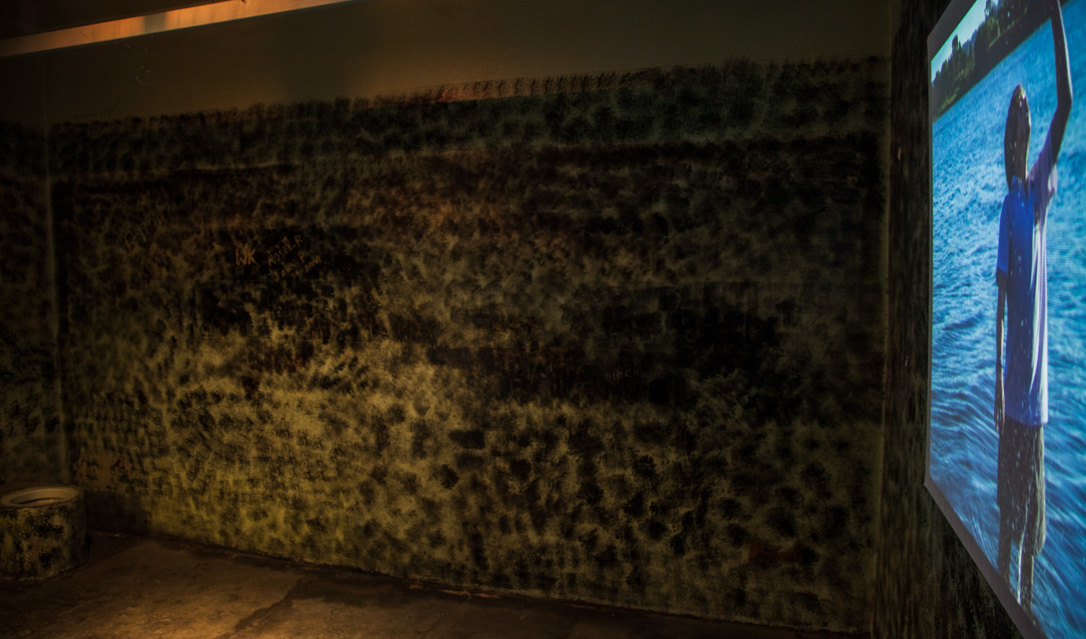

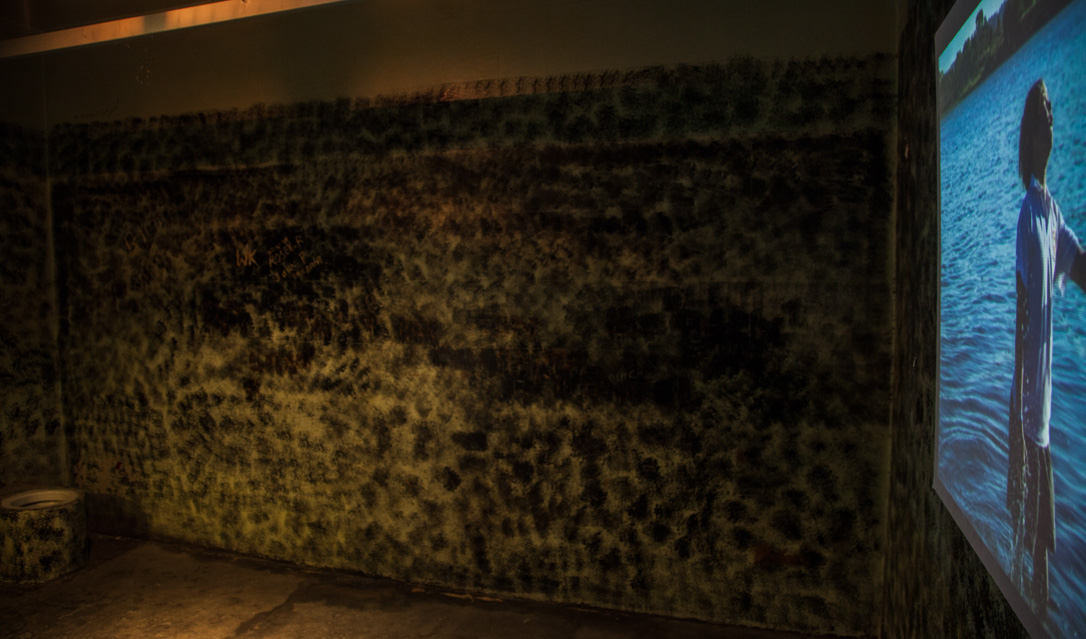
Six Degrees of Separation: Eli from the series Jubilee Venn Diagrams? install views 1 - 5
Facing Futures Free From Fear (2013)

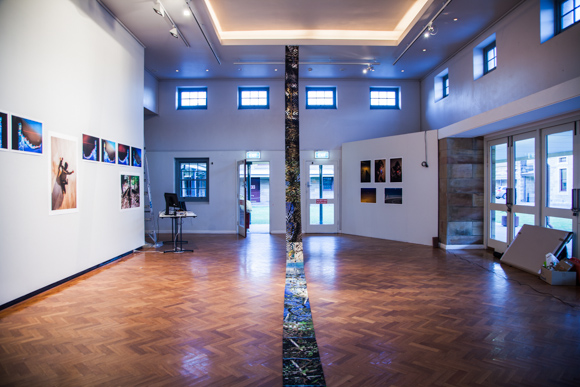



The fable of King Canute and the sea goes that in 01028 the King took his throne to the sea shore and sat in it in while he demonstrated he could command the tide to stop rising before it reached his chair. The laws of gravity with the orbit of moon and the attraction of the sun continued as they were. The tide rose. He remained stationary. His body wet. The King retreated, either into a newfound humility toward the forces of nature or in recognition of not possessing dominion over nature.
One millennium later, in 02028, asteroid 1997 XF11 will pass us by, around 2.4 times the distance between the earth and the moon. The announcement of this 1km wide asteroid in March 01998 caused widespread alarm as the initial calculations predicated a remarkably higher likelihood of collision with the earth than any others in the near future. More accurate calculations quickly followed, which asserted there was no likelihood of impact, but not before the initial trajectory stirred a public imagination in asteroid XF11 being ‘the one’ that, on the balance of probabilities, this planet is long overdue to receive.
One month later, in April 01998, a highly influential article on climate change was published. This was the ‘hockey stick’ argument, so called because the graph showed relatively rapid temperature increases since the beginning of the 20th Century, relative to the time since King Canute. The 1000 years represented by this line form a shape like a hockey stick: relatively straight for a long period of time, followed by an exponential curve upwards over a relatively small timescale. The contours of the human arm+head share this shape: stretching your arm out flat, like in King Canute’s posture toward the sea he sought to control, you look back along a relatively straight line toward your fingertips. What the eyes cannot sea as clearly is the area of near-history: the approaching vertical rise beginning at the base of the neck and traveling up along the contours of the head. This near-history area is so close to our sensors that we appear to have a blind spot for it. Blind or not, we do know the head is significantly higher than the outstretched arm as we couldn’t otherwise see so clearly down the length of the arm.
The diptych portraits are set in the midst of this period of near-history: the year 02028. They show different sea level heights in ‘best case’ (less than 2° temperature increase) and ‘worst case’ (more than 2° temperature increase) scenarios over the century leading up to 02028. Their base rate is February 02010, which is one nutation of the earth before asteroid XF11 will pass by. It is within this single nutation that climate scientists are calling The Critical Decade: the period in which the tipping point for limiting increases to less than 2° will or will not be breached. The base rate is taken as the base of one’s neck as this is the universal height the sea comes up to on a buoyant body. It is us, any of us, treading water three summers ago in the sea. It is a situation of being in it up to our necks, with a narrowing margin remaining for the rate of rise to not outstrip the buoyancy of the body, like an ocean wave washing overhead while ones body remains stationary.
The difference between these futures boil down to the difference of 2°. Increases of less or more than 2° higher than the pre-industrial era are understood to be the main tolerance threshold for the physical systems which support life to continue functioning like they have in the unseasonably benign period since our civilisation emerged from its cradle. In one scenario for the future, these life support systems are maimed, yet marginally maintained: our mouth and nose sit above the level of the sea. In the other, life ceases to be life as we know it…
Three thousand millenniums earlier life on this planet made do with a concentration of 400 parts per million of C02 in the atmosphere, with average temperatures 3-4° warmer than today, and average sea levels 5-40 metres higher than now. As of May 02013, for the first time in the intervening three thousand millenniums, we have returned the atmosphere to a concentration of 400 parts per million of C02.
That wave that we have recreated rises up from our feet to well, well over our heads, and with it all the detritus of the lifeforms it subsumes in its path. That wave is a heatmap/timeline of the trajectory plotted by the Keeling Curve’s continuous vigil since 01958 of the increasingly increasing concentrations of C02 in the atmosphere, which eyes looking beyond our blind spot look to for the most authoritative barometer of what these critical numbers mean for how we face our futures. The wave is a tapestry of interwoven strips of Northern Territory, Far North Queensland and Tongan littoral zones, where these biomes at the front line meet the shifting shorelines. It paints a picture of colour/temperature from darkest/coldest to lightest/hottest, as expanded by two new colours added by the Bureau of Meteorology in January 02013 to compensate for the addition of 52° and 54° to our palette of life as we now know it. Meanwhile, the portraits stand in vigil side-by-side, encircling the wave that parts them, amidst a wall of voices on matters past, present and future.
Facing Futures Free From Fear has been assisted by the Sydney College of the Arts Research Residency Program, the Bundanon Trust Residency Program and supported by a NAVA Australian Artists' Grant, a NAVA initiative made possible through the generous sponsorship of Mrs Janet Holmes a Court and the support of the Visual Arts Board, Australia Council for the Arts.
It is a companion piece to ISEA Bright Future, an interactive audiovisual installation about communal energy production, biomimesis and bioluminescence. Both installations are on in Sydney in June 2013.
Previous installation
Sydney College of the Arts
Auditorium Gallery
Opening 6pm May 22
by Ross Gibson
Professor of Contemporary Arts
Sydney College of the Arts
University of Sydney
part of Head On Photo Festival 2013
May 22 - June 14 2013
Balmain Road, Rozelle
D#generative (2004-7)
D#generative is a triptych of three 110x170cm canvases that are intermediaries between painting and sculpture. Being made without paint, D#generative is an ‘ing’: as ‘painting’ minus ‘paint’ =‘ing’, defined as the material substrate used in any process. The triptych was put flat on the ground by the veranda used for Sly Drooler, to be exposed to elements of rain, soil, wind, native and non-native garden leaves and 'fed' organic materials on average once a week for three years. Presence of Absence (the left side canvas) was fed globally sourced used coffee and tea from Nicaragua, Ethiopia, Sumatra, East Timor, India, Sri Lanka, Mexico, Honduras and Cuba. Absence of Presence (the right side canvas) was fed Australian, but predominantly local ACT+NSW fruit and vegetables. Whatever Will will be Will will be (the middle canvas) had Australian bird seed suspended above it, so it received mixed local-global materials, given the porous roaming of 'Australian' birds and the xenophobic nature of their shit.
Animals and humans walked over the canvases numerous times while they lay on the ground ‘evolving’ in interaction with environmental microbiology. In Presence of Absence and Absence of Presence, a dialogue was formed between my weekly feeding (by selecting ingredients and where and how I placed them on the canvases), and ongoing observation of the interactions between these foodstuffs and the material substrate of the canvas. By contrast, in Whatever Will will be Will will be my dialogue was negotiated in selecting and replacing the bird seed when the birds and possums had eaten it all. Despite 2 inch gaffer tape separating the canvas into three sections, leakages between the arbitrary boundaries of global and local foodstuffs inevitably occurred due to wind and rain.
The resulting patterns, colours, shapes and forms are like a geological timespan of photography exposure: that which happened on/to them left cumulative indelible impressions+indentations, which interacted with innumerable other decomposing compositions. Their final forms were determined by their progressive decomposition, as the microorganisms, mold and fungus were literally devouring the actual canvas, forming large holes. After three years, all but the base layer of surface materials was removed and each was sealed with acrylic sealant. The canvasses were then stretched over wooden frames and hung vertically, side-by-side.
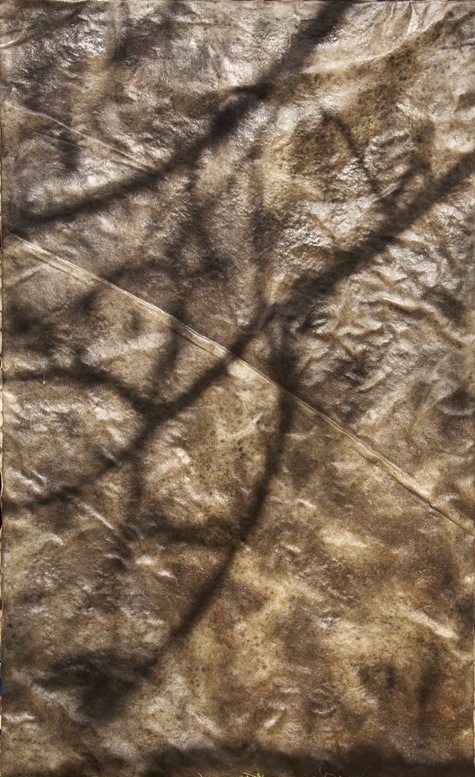
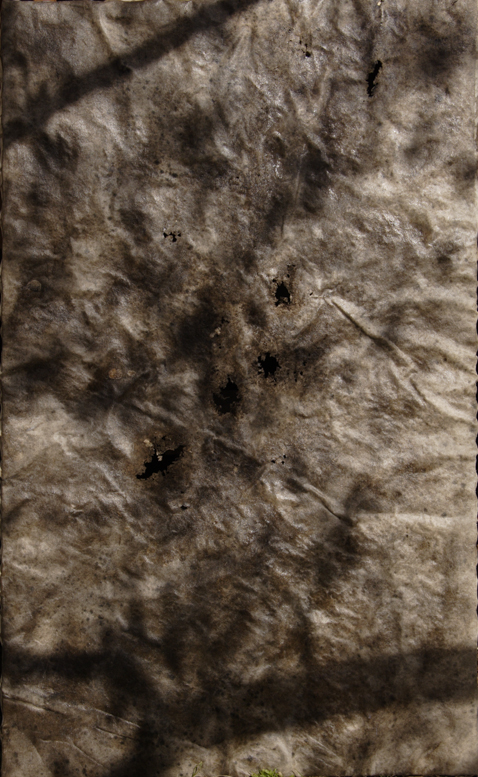

Presence of Absence | Whatever Will will be Will will be | Absence of Presence |
InvertedPreverted (2004-5)
InvertedPreverted are two 170x206cm sized paintings superimposed onto each other, forming inverted/reverted/perverted binaries. Inverted refers to black paint on white canvas and white paint on black canvas, to composite inverted background and foreground colours. The colour binaries are mapped onto their form: paint strokes are long/short dashes or small/large circular shapes, as a reference to binary logic of ‘1’s and ‘0’s and Morse code. Preverted is a malapropism of reverted and perverted: the work is perverted in the sense of altering something from an original state. This arises from the malleable form, as the vertical proportions can be variably retracted to allow different portions of natural light to enter around the canvas, and when extended over a doorway, the 'aesthetic' can be reduced to 'functional' when the doorway is used.
As it can be viewed from the outside looking in and inside looking out, InvertedPreverted takes on different properties according to different lighting, so it is backlit during daylight hours and frontlit by interior lights at night. This varies the opacity between the two paintings, so at any one time different portions have different levels of visibility. This means that differing and indeterminable amounts of the black paint on white canvas intermingle with white paint on the black canvas.

From the inside looking out during daytime, with Inverted partly visible through Preverted
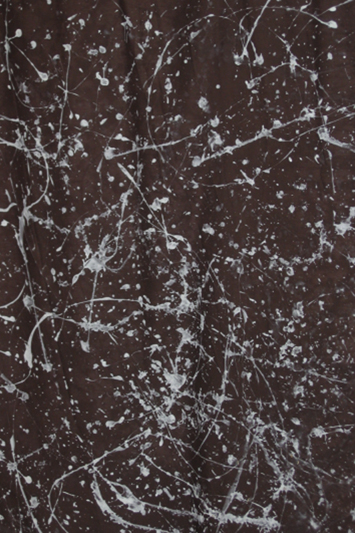

From the inside looking out at Preverted During nighttime | From the outside looking in at Inverted during daytime
Sly Drooler (2004-5)
Sly Drooler is a sculpture made of parallel lines of 35mm film strips and their multi-channel soundtracks. They were woven through the banister around the veranda, running between InvertedPreverted and D#generative. While appearing to be physically static, progressive disintegration due to wind, rain and sun exposure produced differentiated decomposition between individual slides and between strips of slides. The audiovisual content in Sly Drooler is accessed via film projectors and amplifiers which reproduce the indeterminably decomposed audiovisual content embedded in the film strips.
Sly Drooler anachronistically refers to slide rulers as mechanical analogue computers (with the title a spoonerism of ‘slide rulers’). It represents a 3D visualisation of techniques of combining form, content and Interaction Design to balance interactivity and narrativity in narrative-based Interactive Art. While Sly Drooler used static form to represent the dynamic processes of these techniques, the patterned placement of each row of slides represents the multiple simultaneous interwoven non-linear narrative threads used in the narrative-based artworks Tat Avam Asi (Kali Yuga) [v2], 3forthree and Emergence.

